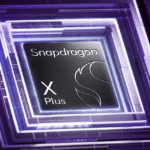If you’re looking for a 14-inch laptop, you have a ton of great choices. If you include the Apple MacBook Air 13 with its 13.6-inch display (and you should), then the field is incredibly strong. But Apple isn’t the only company making great laptops that balance portability with a slightly larger screen size.
The Lenovo Yoga Slim 9i 14 Gen 10 is a brand-new entry that features a gorgeous chassis and Intel’s latest Lunar Lake chipset. Pitting it against the MacBook Air makes a great deal of sense, but which one of these laptops comes out on top?
Specs and configurations
| Lenovo Yoga Slim 9i 14 Gen 10 | Apple MacBook Air M3 | |
| Dimensions | 12.31 x 8.01 x 0.57 inches | 11.97 inches x 8.46 inches x 0.44 inches |
| Weight | 2.76 pounds | 2.7 pounds |
| CPU | Intel Core Ultra 7 256V Intel Core Ultra 7 258V |
Apple M3 (8-core) |
| GPU | Intel Arc 140V | 8 GPU cores 10 GPU cores |
| RAM | 16GB 32GB |
16GB 24GB |
| Display | 14.0-inch 4K+ (3840 x 2400) OLED, 120Hz | 13.6-inch 16:10 Liquid Retina (2560 x 1664) IPS |
| Storage | 1TB SSD | 256GB SSD 512GB SSD 1TB SSD 2TB SSD |
| Ports | 2 x USB-C with Thunderbolt 4 | 2 x USB-C with Thunderbolt 4 1 x 3.5mm audio jack 1 x MagSafe 3 |
| Touch | Yes | No |
| Wireless | Wi-Fi 7 and Bluetoth 5.4 | Wi-Fi 6E and Bluetooth 5.3 |
| Webcam | 32MP with infrared camera for Windows 11 Hello | 1080p |
| Battery | 75 watt-hour | 52.6 watt-hours |
| Operating system | Windows 11 | macOS Sonoma |
| Price | $1,760+ | $1,099+ |
| Rating | 4 out of 5 stars | 4 out of 5 stars |
Right now, there are only two configurations of the Yoga Slim 9i 14 Gen 10 available. For $1,760, you get an Intel Core Ultra 7 256V chipset, 16GB of RAM, a 1TB SSD, and a 4K+ OLED display (the only option). For $1,835, you can upgrade to a slightly faster Core Ultra 7 258V with 32GB of RAM. That’s the reviewed configuration.
The MacBook Air 13 has a starting price of $1,099 for the 8-core CPU/8-core GPU version of the M3 chipset, a 512GB SSD, and a 13.6-inch 2560 x 1664 IPS display (again, the only option). Apple just recently increased RAM to 16GB with the base model for the same price, making the laptop more competitive with similar Windows machines. You can upgrade to an 8-core CPU/10-core GPU M3, and a 512GB SSD brings the price to $1,299, while the high-end model is $2,099 for 24GB of RAM and a 2TB SSD.
Both laptops are premium machines, and the MacBook Air 13 starts at a lower price. You’ll spend more to fully upgrade the MacBook Air 13, however.
Design
The Yoga Slim 9i 14 Gen 10 is simply a beautiful laptop. Its dark blue color way is consistent except for a brighter blue that I think was a minor design mistake, and the glass cover on the lid gives the laptop a lovely sheen. The dark chrome edges are rounded, so they both look and feel great, and the overall aesthetic stands out without being aesthetic. If you’re looking for a great looking laptop, the Yoga Slim 9i qualifies. The MacBook Air 13 is also an elegant machine, which a more minimalist design that’s shared with Apple’s entire MacBook lineup. It comes in several attractive colors, and it, too, is a great looking laptop. You can’t go wrong with either machine.

Both laptops are also solidly built of all-aluminum, although they share the same attribute of a slightly bendable lid. It’s not egregious with either laptop, but the Yoga Slim 9i’s glass cover is a little more concerning. I’m sure it’s reasonably robust, but the fact that it’s glass does give me a bit of a pause. Nevertheless, I’d rather them as equally well-built.
The MacBook Air 13 is among the thinnest laptops you can buy today, at 0.44 inches, but the Yoga Slim 9i is pretty great too at just 0.57 inches. They weigh almost the same, which gives the MacBook Air 13 a slightly denser feel in hand. The Yoga Slim 9i has insanely thin display bezels all the way around, with a webcam that’s underneath the display. That makes it seem narrower even thought it’s actually a bit wider given its larger display, and it’s almost half an inch shallower. These are both eminently portable laptops.
Performance

The Yoga Slim 9i 14 Gen 10 uses Intel Lunar Lake chipsets, also known as Core Ultra Series 2. I reviewed the laptop with the Core Ultra 7 258V, an eight-core (four Performance and four Low Power Performance), eight-thread chipset consuming 17 watts of power. That makes it a low-power chipset aimed at thin-and-light machines, with an eye to efficiency over sheer performance. As such, it’s fast enough for demanding productivity tasks, but its integrated Intel Arc 140V graphics aren’t great for gamers or creators.
The MacBook Air 13 currently uses the Apple Silicon M3 chipset, which we reviewed in its 8-core CPU/10-core GPU iteration. It’s a very fast chipset, particularly in single-core performance, and its GPU cores are faster than Intel integrated graphics. The M3 also has various optimization that help speed up various creative tasks, making the MacBook Air 13 better for anyone who’s doing demanding tasks like video editing.
Ultimately, both laptops perform similarly. Note that Apple will be releasing the MacBook Air with the M4 chipset relatively soon, so it’s likely that it will take a lead here.
| Geekbench 6 (single/multi) |
Cinebench R24 (single/multi/battery) |
Handbrake | 3DMark Wild Life Extreme |
|
| Lenovo Yoga Slim 9i 14 Gen 10 (Core Ultra 7 258V / Intel Arc 140V) |
2723 / 10884 | 121 / 649 | 91 | 5397 |
| Apple MacBook Air M3 (M3 8/10) |
3,102 / 12,078 | 141 / 601 | 109 | 8098 |
Display and audio

There’s just one display option with the Yoga Slim 9i 14 Gen 10, a 14.0-inch 16:10 4K+ (3840 x 2400) OLED display running at 120Hz. That’s as sharp as you can get, and it’s become unusual in 14-inch machines that usually top out at 2.8K (2880 x 1800). The display is simply spectacular, with bright, dynamic colors and inky blacks to go with that ultimate sharpness.
The MacBook Air 13 has a more pedestrian 13.6-inch 16:10 Liquid Retina (2560 x 1664) IPS running 60Hz. It’s a very good display, with good colors and great brightness, and its contrast ratio is also very good. But, it just doesn’t have the same kind of pop.
Looking at our colorimeter results, you can see that Lenovo’s chosen OLED panel is about as high-quality as you’ll find today. It’s great display for any purpose, including productivity, creativity, and media consumption. You won’t mind the MacBook Air 13’s display, but you’ll adore the Yoga Slim 9i’s.
| Lenovo Yoga Slim 9i 14 Gen 10 (OLED) |
Apple MacBook Air M3 (IPS) |
|
| Brightness (nits) |
417 | 496 |
| AdobeRGB gamut | 96% | 87% |
| sRGB gamut | 100% | 100% |
| DCI-P3 gamut | 100% | 99% |
| Accuracy (DeltaE, lower is better) |
0.55 | 1.24 |
| Contrast | 28,790:1 | 1,480:1 |
Both laptops have 4-speaker audio systems with dual woofers. They’re similar in quality, with plenty of loudness, clear mids and highs, and more bass than usual. That makes them both better than you’ll find on most 14-inch laptops.
Portability
Both laptops are highly portable, and almost equally so. You can stick them in a backpack and forget they’re there until you need them.
As mentioned above, the Lunar Lake chipset is aimed more at efficiency than performance. In some other laptops, it does better than the Yoga Slim 9i, which was closer to previous-generation Intel laptops. Note that Lunar Lake is a direct response to Apple Silicon, which has taken the lead in efficiency and hasn’t looked back.
The MacBook Air 13 has much better battery life, and it can last more than a full day of actual work. The Yoga Slim cannot.
| Video | Cinebench R24 |
|
| Lenovo Yoga Slim 9i 14 Gen 10 (Core Ultra 7 258V) |
13 hours, 45 minutes | 1 hour, 55 minutes |
| Apple MacBook Air M3 (M3 8/10) |
19 hours, 39 minutes | 3 hours, 27 minutes |
The Yoga Slim 9i 14 is gorgeous, the MacBook Air is faster and longer-lasting
The Yoga Slim 9i 14 Gen 10 is a great laptop with one of the most aesthetically pleasing designs around. It’s reasonably thin and light, and it has more than good enough performance. And its display is sublime.
But, the MacBook Air 13 is faster overall, and it gets much better battery life.
Read the full article here















